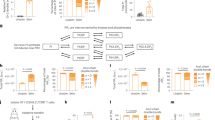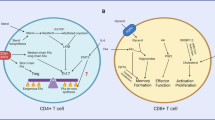Abstract
Anergic T cells have altered diacylglycerol metabolism, but whether that altered metabolism has a causative function in the induction of T cell anergy is not apparent. To test the importance of diacylglycerol metabolism in T cell anergy, we manipulated diacylglycerol kinases (DGKs), which are enzymes that terminate diacylglycerol-dependent signaling. Overexpression of DGK-α resulted in a defect in T cell receptor signaling that is characteristic of anergy. We generated DGK-α-deficient mice and found that DGK-α-deficient T cells had more diacylglycerol-dependent T cell receptor signaling. In vivo anergy induction was impaired in DGK-α-deficient mice. When stimulated in anergy-producing conditions, T cells lacking DGK-α or DGK-ζ proliferated and produced interleukin 2. Pharmacological inhibition of DGK-α activity in DGK-ζ-deficient T cells that received an anergizing stimulus proliferated similarly to wild-type T cells that received CD28 costimulation and prevented anergy induction. Our findings suggest that regulation of diacylglycerol metabolism is critical in determining whether activation or anergy ensues after T cell receptor stimulation.
This is a preview of subscription content, access via your institution
Access options
Subscribe to this journal
Receive 12 print issues and online access
$209.00 per year
only $17.42 per issue
Buy this article
- Purchase on Springer Link
- Instant access to full article PDF
Prices may be subject to local taxes which are calculated during checkout








Similar content being viewed by others
References
Mathis, D. & Benoist, C. Back to central tolerance. Immunity 20, 509–516 (2004).
Bouneaud, C., Kourilsky, P. & Bousso, P. Impact of negative selection on the T cell repertoire reactive to a self-peptide: a large fraction of T cell clones escapes clonal deletion. Immunity 13, 829–840 (2000).
Schwartz, R.H. T cell anergy. Annu. Rev. Immunol. 21, 305–334 (2003).
Kopp, E. & Medzhitov, R. Recognition of microbial infection by Toll-like receptors. Curr. Opin. Immunol. 15, 396–401 (2003).
Heissmeyer, V. et al. Calcineurin imposes T cell unresponsiveness through targeted proteolysis of signaling proteins. Nat. Immunol. 5, 255–265 (2004).
Safford, M. et al. Egr-2 and Egr-3 are negative regulators of T cell activation. Nat. Immunol. 6, 472–480 (2005).
Gajewski, T.F., Qian, D., Fields, P. & Fitch, F.W. Anergic T-lymphocyte clones have altered inositol phosphate, calcium, and tyrosine kinase signaling pathways. Proc. Natl. Acad. Sci. USA 91, 38–42 (1994).
Wells, A.D. et al. Regulation of T cell activation and tolerance by phospholipase C γ-1-dependent integrin avidity modulation. J. Immunol. 170, 4127–4133 (2003).
Kang, S.M. et al. Transactivation by AP-1 is a molecular target of T cell clonal anergy. Science 257, 1134–1138 (1992).
Li, W., Whaley, C.D., Mondino, A. & Mueller, D.L. Blocked signal transduction to the ERK and JNK protein kinases in anergic CD4+ T cells. Science 271, 1272–1276 (1996).
Fields, P.E., Gajewski, T.F. & Fitch, F.W. Blocked Ras activation in anergic CD4+ T cells. Science 271, 1276–1278 (1996).
Acuto, O., Mise-Omata, S., Mangino, G. & Michel, F. Molecular modifiers of T cell antigen receptor triggering threshold: the mechanism of CD28 costimulatory receptor. Immunol. Rev. 192, 21–31 (2003).
Frauwirth, K.A. & Thompson, C.B. Regulation of T lymphocyte metabolism. J. Immunol. 172, 4661–4665 (2004).
Lindstein, T., June, C.H., Ledbetter, J.A., Stella, G. & Thompson, C.B. Regulation of lymphokine messenger RNA stability by a surface-mediated T cell activation pathway. Science 244, 339–343 (1989).
Blanchet, F., Cardona, A., Letimier, F.A., Hershfield, M.S. & Acuto, O. CD28 costimulatory signal induces protein arginine methylation in T cells. J. Exp. Med. 202, 371–377 (2005).
Shapiro, V.S., Truitt, K.E., Imboden, J.B. & Weiss, A. CD28 mediates transcriptional upregulation of the interleukin-2 (IL-2) promoter through a composite element containing the CD28RE and NF-IL-2B AP-1 sites. Mol. Cell. Biol. 17, 4051–4058 (1997).
Cory, S. & Adams, J.M. The Bcl2 family: regulators of the cellular life-or-death switch. Nat. Rev. Cancer 2, 647–656 (2002).
Fox, C.J., Hammerman, P.S. & Thompson, C.B. Fuel feeds function: energy metabolism and the T-cell response. Nat. Rev. Immunol. 5, 844–852 (2005).
Jenkins, M.K., Pardoll, D.M., Mizuguchi, J., Chused, T.M. & Schwartz, R.H. Molecular events in the induction of a nonresponsive state in interleukin 2-producing helper T-lymphocyte clones. Proc. Natl. Acad. Sci. USA 84, 5409–5413 (1987).
Macian, F. et al. Transcriptional mechanisms underlying lymphocyte tolerance. Cell 109, 719–731 (2002).
Su, B. et al. JNK is involved in signal integration during costimulation of T lymphocytes. Cell 77, 727–736 (1994).
Harhaj, E.W. & Sun, S.C. IκB kinases serve as a target of CD28 signaling. J. Biol. Chem. 273, 25185–25190 (1998).
Lyakh, L., Ghosh, P. & Rice, N.R. Expression of NFAT-family proteins in normal human T cells. Mol. Cell. Biol. 17, 2475–2484 (1997).
Dolmetsch, R.E., Lewis, R.S., Goodnow, C.C. & Healy, J.I. Differential activation of transcription factors induced by Ca2+ response amplitude and duration. Nature 386, 855–858 (1997).
Dower, N.A. et al. RasGRP is essential for mouse thymocyte differentiation and TCR signaling. Nat. Immunol. 1, 317–321 (2000).
Luo, B., Regier, D.S., Prescott, S.M. & Topham, M.K. Diacylglycerol kinases. Cell. Signal. 16, 983–989 (2004).
Zhong, X.P. et al. Enhanced T cell responses due to diacylglycerol kinase-ζ deficiency. Nat. Immunol. 4, 882–890 (2003).
Zhong, X.P. et al. Regulation of T cell receptor-induced activation of the Ras-ERK pathway by diacylglycerol kinase ζ. J. Biol. Chem. 277, 31089–31098 (2002).
Berney, S.M. & Atkinson, T.P. Phosphatidylinositol hydrolysis in freshly isolated human T lymphocytes. J. Immunol. Methods 186, 71–77 (1995).
Antony, P. et al. B-cell antigen receptor activates transcription factors NFAT (nuclear factor of activated T-cells) and NF-κB (nuclear factor κB) via a mechanism that involves diacylglycerol. Biochem. Soc. Trans. 32, 113–115 (2004).
Rellahan, B.L., Jones, L.A., Kruisbeek, A.M., Fry, A.M. & Matis, L.A. In vivo induction of anergy in peripheral Vβ8+ T cells by staphylococcal enterotoxin B. J. Exp. Med. 172, 1091–1100 (1990).
Kawabe, Y. & Ochi, A. Selective anergy of Vβ8+,CD4+ T cells in staphylococcus enterotoxin B-primed mice. J. Exp. Med. 172, 1065–1070 (1990).
Jiang, Y., Sakane, F., Kanoh, H. & Walsh, J.P. Selectivity of the diacylglycerol kinase inhibitor 3-[2-(4-[bis-(4-fluorophenyl)methylene]-1-piperidinyl)ethyl]-2, 3-dihydro-2-thioxo-4(1H)quinazolinone (R59949) among diacylglycerol kinase subtypes. Biochem. Pharmacol. 59, 763–772 (2000).
Jones, D.R., Sanjuan, M.A., Stone, J.C. & Merida, I. Expression of a catalytically inactive form of diacylglycerol kinase α induces sustained signaling through RasGRP. FASEB J. 16, 595–597 (2002).
Merida, I., Williamson, P., Smith, K. & Gaulton, G.N. The role of diacylglycerol kinase activation and phosphatidate accumulation in interleukin-2-dependent lymphocyte proliferation. DNA Cell Biol. 12, 473–479 (1993).
Williamson, P., Merida, I. & Gaulton, G. Protein and lipid kinase activation cascades in interleukin-2 receptor signalling. Semin. Immunol. 5, 337–344 (1993).
Flores, I., Casaseca, T., Martinez, A.C., Kanoh, H. & Merida, I. Phosphatidic acid generation through interleukin 2 (IL-2)-induced α-diacylglycerol kinase activation is an essential step in IL-2-mediated lymphocyte proliferation. J. Biol. Chem. 271, 10334–10340 (1996).
Jones, D.R., Flores, I., Diaz, E., Martinez, C. & Merida, I. Interleukin-2 stimulates a late increase in phosphatidic acid production in the absence of phospholipase D activation. FEBS Lett. 433, 23–27 (1998).
Flores, I. et al. Diacylglycerol kinase inhibition prevents IL-2-induced G1 to S transition through a phosphatidylinositol-3 kinase-independent mechanism. J. Immunol. 163, 708–714 (1999).
Boonen, G.J. et al. CD28 induces cell cycle progression by IL-2-independent down-regulation of p27kip1 expression in human peripheral T lymphocytes. Eur. J. Immunol. 29, 789–798 (1999).
Jenkins, M.K. The role of cell division in the induction of clonal anergy. Immunol. Today 13, 69–73 (1992).
Topham, M.K. & Prescott, S.M. Mammalian diacylglycerol kinases, a family of lipid kinases with signaling functions. J. Biol. Chem. 274, 11447–11450 (1999).
English, D. Phosphatidic acid: a lipid messenger involved in intracellular and extracellular signalling. Cell. Signal. 8, 341–347 (1996).
Avila-Flores, A., Santos, T., Rincon, E. & Merida, I. Modulation of the mammalian target of rapamycin pathway by diacylglycerol kinase-produced phosphatidic acid. J. Biol. Chem. 280, 10091–10099 (2005).
Jones, G.A. & Carpenter, G. The regulation of phospholipase C-γ1 by phosphatidic acid. Assessment of kinetic parameters. J. Biol. Chem. 268, 20845–20850 (1993).
Luo, B., Prescott, S.M. & Topham, M.K. Diacylglycerol kinase ζ regulates phosphatidylinositol 4-phosphate 5-kinase Iα by a novel mechanism. Cell. Signal. 16, 891–897 (2004).
Lauener, R., Shen, Y., Duronio, V. & Salari, H. Selective inhibition of phosphatidylinositol 3-kinase by phosphatidic acid and related lipids. Biochem. Biophys. Res. Commun. 215, 8–14 (1995).
Sanjuan, M.A. et al. T cell activation in vivo targets diacylglycerol kinase α to the membrane: a novel mechanism for Ras attenuation. J. Immunol. 170, 2877–2883 (2003).
Fukunaga-Takenaka, R. et al. Importance of chroman ring and tyrosine phosphorylation in the subtype-specific translocation and activation of diacylglycerol kinase α by D-α-tocopherol. Genes Cells 10, 311–319 (2005).
Ali, H. et al. Selective translocation of diacylglycerol kinase ζ in hippocampal neurons under transient forebrain ischemia. Neurosci. Lett. 372, 190–195 (2004).
D'Santos, C.S., Clarke, J.H., Irvine, R.F. & Divecha, N. Nuclei contain two differentially regulated pools of diacylglycerol. Curr. Biol. 9, 437–440 (1999).
Topham, M.K. et al. Protein kinase C regulates the nuclear localization of diacylglycerol kinase-ζ. Nature 394, 697–700 (1998).
Abramovici, H., Hogan, A.B., Obagi, C., Topham, M.K. & Gee, S.H. Diacylglycerol kinase-zeta localization in skeletal muscle is regulated by phosphorylation and interaction with syntrophins. Mol. Biol. Cell 14, 4499–4511 (2003).
Cipres, A. et al. Regulation of diacylglycerol kinase α by phosphoinositide 3-kinase lipid products. J. Biol. Chem. 278, 35629–35635 (2003).
Luo, B., Prescott, S.M. & Topham, M.K. Protein kinase C α phosphorylates and negatively regulates diacylglycerol kinase ζ. J. Biol. Chem. 278, 39542–39547 (2003).
Vakoc, C.R., Mandat, S.A., Olenchock, B.A. & Blobel, G.A. Histone H3 lysine 9 methylation and HP1γ are associated with transcription elongation through mammalian chromatin. Mol. Cell 19, 381–391 (2005).
Acknowledgements
We thank C. Bock and D. Snyder (Transgenic and Knock-out Mouse Core Facility, Comprehensive Cancer Center, Duke University, Durham, North Carolina) for generating targeted embryonic stem clones and chimeric mice, and J. Stadanlick for critical review of the manuscript. Supported by the Huntsman Cancer Foundation (M.K.T.), the US National Institutes of Health (CA95463 to M.K.T. and R01 AI058019 to G.A.K.), the Department of Energy (DEFG0204ER63829 to M.K.T.) and the National Cancer Institute (T32CA09140 to B.A.O.).
Author information
Authors and Affiliations
Contributions
B.A.O., R.G., J.H.C. and M.J. contributed experimental work and data analyses; M.K.T. contributed essential reagents; G.A.K. and X.-P.Z. supervised the studies; and all authors contributed intellectually to the project.
Corresponding authors
Ethics declarations
Competing interests
The authors declare no competing financial interests.
Supplementary information
Supplementary Fig. 1
Amounts of transcripts encoding DGK-α and DGK-ζ decreased after T cell activation. (PDF 51 kb)
Supplementary Fig. 2
Generation of Dgka-/- mice. (PDF 79 kb)
Supplementary Fig. 3
DGK-α deficiency does not affect T cell development. (PDF 80 kb)
Supplementary Fig. 4
DGK-α deficiency does not alter phenotype of peripheral CD8+ cells. (PDF 63 kb)
Supplementary Fig. 5
DGK-α deficiency increases T cell proliferation in response to anergizing stimuli. (PDF 57 kb)
Rights and permissions
About this article
Cite this article
Olenchock, B., Guo, R., Carpenter, J. et al. Disruption of diacylglycerol metabolism impairs the induction of T cell anergy. Nat Immunol 7, 1174–1181 (2006). https://doi.org/10.1038/ni1400
Received:
Accepted:
Published:
Issue Date:
DOI: https://doi.org/10.1038/ni1400
This article is cited by
-
Multimodal immunogenomic biomarker analysis of tumors from pediatric patients enrolled to a phase 1-2 study of single-agent atezolizumab
Nature Cancer (2023)
-
Combination therapy for hepatocellular carcinoma with diacylglycerol kinase alpha inhibition and anti-programmed cell death-1 ligand blockade
Cancer Immunology, Immunotherapy (2022)
-
Rethinking peripheral T cell tolerance: checkpoints across a T cell’s journey
Nature Reviews Immunology (2021)
-
Diacylglycerol kinase α inhibition cooperates with PD-1-targeted therapies to restore the T cell activation program
Cancer Immunology, Immunotherapy (2021)
-
The mechanisms of ameliorating effect of a green tea polyphenol on diabetic nephropathy based on diacylglycerol kinase α
Scientific Reports (2020)



